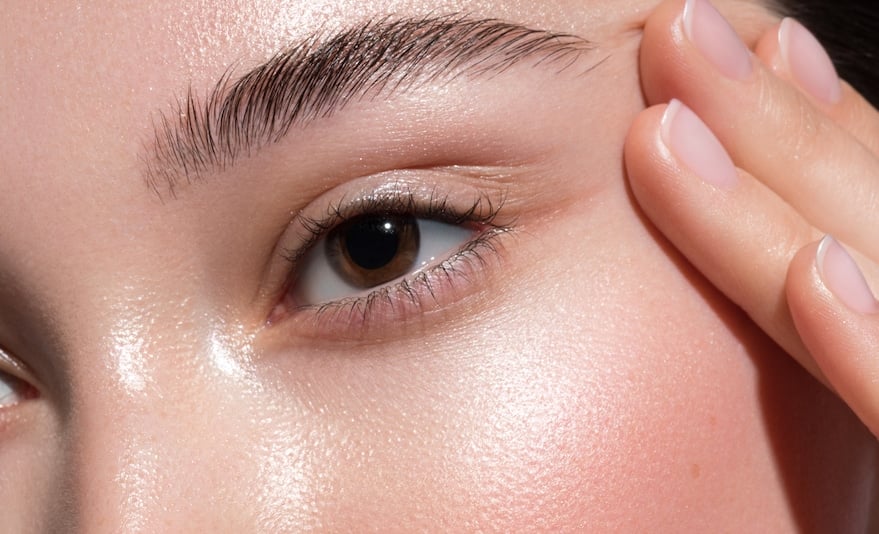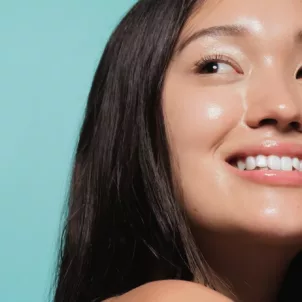Your skin’s pH level matters more than you think: If it’s off-balance, you could experience premature aging, acne, or eczema. An expert breaks down everything to know, including how to restore your skin’s optimal pH level (and how to keep it there long-term).
Hearing the word “pH” may transport you back to high school science class, but even if you didn’t ace chemistry, it turns out there’s a beauty benefit to understanding the delicate balance of acids and bases outside the lab. Your skin pH level is critical in maintaining a happy, healthy complexion.
If your complexion’s balance isn’t at the optimal skin pH level, you can experience a variety of unwelcome skin concerns. HUM spoke to a board-certified dermatologist to find out everything to know about your skin’s pH, below.
What Is the pH of the Skin?
“At the most scientific level, pH refers to potential of hydrogen, referring to the concentration of hydrogens,” explains Marisa Garshick, MD, FAAD, a board-certified dermatologist in New York. “The pH indicates how acidic or alkaline (basic) something is, with a higher pH being more basic and a lower pH being more acidic.”
Skin pH refers to the specific pH of the skin, which tends to be more acidic. If you use harsh products (like heavy-duty face washes or intense chemical peels), you may be throwing off the natural balance of your skin, which can negatively impact your skin barrier (the outer layer of your skin that works to keep invaders out and hydration in).
“The skin’s pH is important to maintain optimal skin barrier protection: When the skin’s pH is affected, it can subsequently cause a disruption in the skin barrier, which can lead to moisture loss as well as increased sensitivity or irritation from external factors,” Dr. Garshick says. “The skin may become dry, sensitive, red, flaky, or irritated.”
It takes time to heal your skin barrier and restore your skin’s pH levels once they’ve been affected. Dr. Garshick adds that pH is important for the skin’s microbiome and that disrupting the microbiome can also make the skin more prone to certain conditions.
What Is the Best pH Level for Skin?

The pH scale ranges from 0 to 14. Seven is considered neutral. Skin pH is slightly acid. The ideal skin pH is typically considered 5.5, but can range from 4.5-5.5. What you put on your skin, your environment, and other factors can alter skin pH. According to research, an acid skin pH (4-4.5) keeps the resident bacterial flora attached to the skin, whereas an alkaline pH (8-9) promotes the dispersal from the skin.
For comparison, lemon juice falls around a 2, black coffee a 5, and bleach a 10.
How Can You Tell If Your Skin’s pH Is Off?
If you’re experiencing dryness, breakouts, or tight and sensitive skin, it’s likely your skin pH is off. “The skin may look flaky or red and additionally can be more susceptible to certain skin conditions like acne and eczema.”
Studies have shown that when the pH is off, there may be an increase in fine lines and wrinkles. So if anti-aging is one of your top skincare concerns, it’s important to make sure your pH levels are balanced.
What Causes the pH Balance of Your Skin to Be Off?
But what exactly causes skin pH levels to deviate? “In general, harsh soaps and skincare products can impact the skin’s pH and as a result the skin barrier,” Dr. Garshick says. “Certain acids, such as exfoliating acids, can also impact the skin’s pH.” So while all of those exfoliating products provide benefits for the skin, it is important to avoid over-exfoliating and remember to moisturize the skin. Exfoliate once or twice a week to ensure that you’re not overdoing it and compromising your skin pH levels.
How to Restore the Skin pH Balance Naturally

If you’re dealing with an unbalanced skin pH, there are ways to fix it. Be on the lookout for products that are specifically made to support the skin barrier. “It can help to use products that are designed to restore the skin’s pH by helping to nourish and support the skin barrier,” Dr. Garshick says. “Additionally, many cleansers are now available that don’t use harsh soaps and surfactants, and as a result are more gentle on the skin and the skin’s pH.”
Pro tip: Probiotic skincare products can help support your skin’s pH levels by boosting your skin’s microbiome. The KORRES Greek Yoghurt Foaming Cream Cleanser, is pH-balanced, gentle, and full of skin-loving probiotics from Greek yogurt. “Greek yoghurt is probiotic-rich due to its unique straining process followed in small farms around Greece,” explains Melissa Marca, product marketing manager at KORRES. “Probiotics feed healthy bacteria to balance the skin’s pH and protect against free radical damage while strengthening skin’s health.”
Like everything else in skincare, consistency is key. “Being consistent with a good skincare routine free of harsh chemicals and using probiotic-rich products can help balance your skin’s pH,” Marca says. “Always wash your face before going to sleep (even if you didn’t wear makeup!), hydrate your skin with a balanced moisturizer and tone your skin to exfoliate dead skin cells and decongest pores.” Stick with your gentle, pH-balanced skincare regimen for 3 weeks to see improvement.
The Takeaway
Once you’ve restored your skin’s pH balance, maintenance is key. The biggest thing you can do? Be gentle with your skin. “It can help to stick to gentle cleansers and use products that help to support the skin barrier.” Want an extra boost? Try adding HUM Nutrition’s Glow Sweet Glow into your daily routine to support your skin’s hydration levels from the inside out. If you maintain your skin’s pH at the optimal level, it will look and feel healthy and hydrated. Hello, glow!









